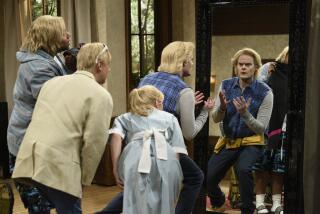THE SIMPSONS: A Complete Guide to Our Favorite Family.<i> Edited by Ray Richmond and Antonia Coffman</i> .<i> Created By Matt Groening</i> .<i> HarperPerennial: 250 pp., $15.95</i>
- Share via
Satire has never done well on American soil. We have, what? Mark Twain? Ambrose Bierce? James Russell Lowell’s “A Fable For Critics”? An unlikely addition to the genre, TV’s “The Simpsons,” a program that is arguably as much a contribution to literature as it is a contribution to popular art, is, to my mind, a classic addition to the genre with its diagnostic literary, social and cultural sophistications.
The show began airing in 1987 and remains extremely popular among kids, so to speak, of all ages, although it seems hard to believe that a full decade has passed since mothers were angrily denouncing the undermining vulgarity of Bart buttons and his slogans, “Eat my shorts,” “Underachiever and proud of it,” “Aye, Carrumba!,” et cetera.
Simpson obsessives, a group that includes doctors, lawyers, college Professors and students, are, I am told, constantly calling the Fox studios in Hollywood to ask about old episodes, to ascertain the names of new ones and to check on new video recordings, which are now passed about like agitprop in the old Soviet Union.
“A Complete Guide to Our Favorite Family,” a handbook of all the episodes and more, is indispensable to fans. We are given biographies of Homer, Marge, Bart, Lisa and Maggie. Each episode is listed in order, formally titled and numbered, and original airdates are given, along with its writers, directors and its guest voices. Special section boxes for each episode include, along with precise plot summaries, “Show Highlights,” “The Stuff You Have Missed” and “Movie Moments,” each of which detail the many splendid little exchanges, ingenious quotes, multiple signs, song lyrics and oblique references that race so quickly by in each of these 22-minute gems. Every character, down to the last animal and pet, is thoroughly delineated.
The vast and loyal audience of “The Simpsons,” not only nationwide but international (Australia has a huge viewership), is passionately aware of the loving details put into each show. There is a sneaky jape seemingly squeezed into each minute of every episode. Signs in the background. Parodies of celebrities. Satirical names and squibs. Snippets of songs. Irreverent jabs. Flashes of sarcasm. Cheap shots. Internal quotes. Freeze-frame jokes.
Editor Antonia Coffman of Fox, who has been with the show from the beginning, told me that up to eight months is required to put together each episode, from the initial scripts to the storyboards to the cold reads, done on Thursdays, to the actors’ recordings, made on Mondays, to the six months required on average to do the animation (with two teams of as many as 100 illustrators working in Hollywood and 100 in Korea). No laugh tracks have ever been used, no small thing in the venal world of television. Creator Matt Groening (rhymes with “complaining”) must have seen many staff changes over the years. It is no small operation. A cult of funsters loves it. There is even a house made up to look like Homer and Marge’s in Henderson, Utah.
Who shot Mr. Burns? Is Smithers gay? How do you spell Apu Nahasapeemapetilon’s surname? This encyclopedic compilation answers every question. What about the early “shorts” from ’87 to ‘89? The “spectaculars”? The Christmas and Thanksgiving shows? The 22 episodes about Springfield, the Simpsons’ hometown? How many “Treehouses of Horror” have been released? The book is specific. We are treated to all the small, hard satisfactions previously appreciated only by hidebound Simpsons trivia hounds.
We learn once again, if indeed we had forgotten, what brand of cigarettes Selma smokes (Laramies), Barney’s regular source of income (the Springfield Sperm Bank), the car Troy McClure drives (a DeLorean), how fat Homer is (between 239 and 260 pounds), Bumblebee Man’s native country (Mexico), the identity of Marge’s date to the senior prom (Artie Ziff), Ned Flanders’ prized possession (Propane Elaine, his gas grill), Krusty the Klown’s ethnicity (Jewish), Rev. Lovejoy’s hobby (toy trains), et cetera.
No detail is skipped. We meet up close and personal everyone from Ralph Wiggum, Pepi, Millicent and Otto to Rabbi Krustofski (“can solve any problem as long as it is posed as an ethical question”) to Moe Szyslak, who claims his forefathers were bartenders to the czar. Add to this, chapters on Who Does What Voice (Dan Castellaneta does 33 characters!); An Itchy and Scratchy Filmography; All the Couch Gags; Krusty’s Merchandising (tote bags, hams, dart games, pacifiers, mugs, et cetera.); and an exhaustive taxonomy on every time Homer says “D’oh”--something like 207 (I counted)--and you will be provided hours of joy with this wonderful book, unless, of course, you are like Lisa.
“I just don’t feel challenged,” she tells principal Seymour Skinner in “The Secret War of Lisa Simpson” (episode 4F21, original airdate: May 18, 1997). Skinner’s comforting and wise reply to her is as legitimate a defense of “Our Favorite Family” as it is of our obsession with it:
“Of course we could make things more challenging, Lisa, but then the stupider students would be in here complaining, furrowing their brows in a vain attempt to understand the situation.”
More to Read
The complete guide to home viewing
Get Screen Gab for everything about the TV shows and streaming movies everyone’s talking about.
You may occasionally receive promotional content from the Los Angeles Times.






